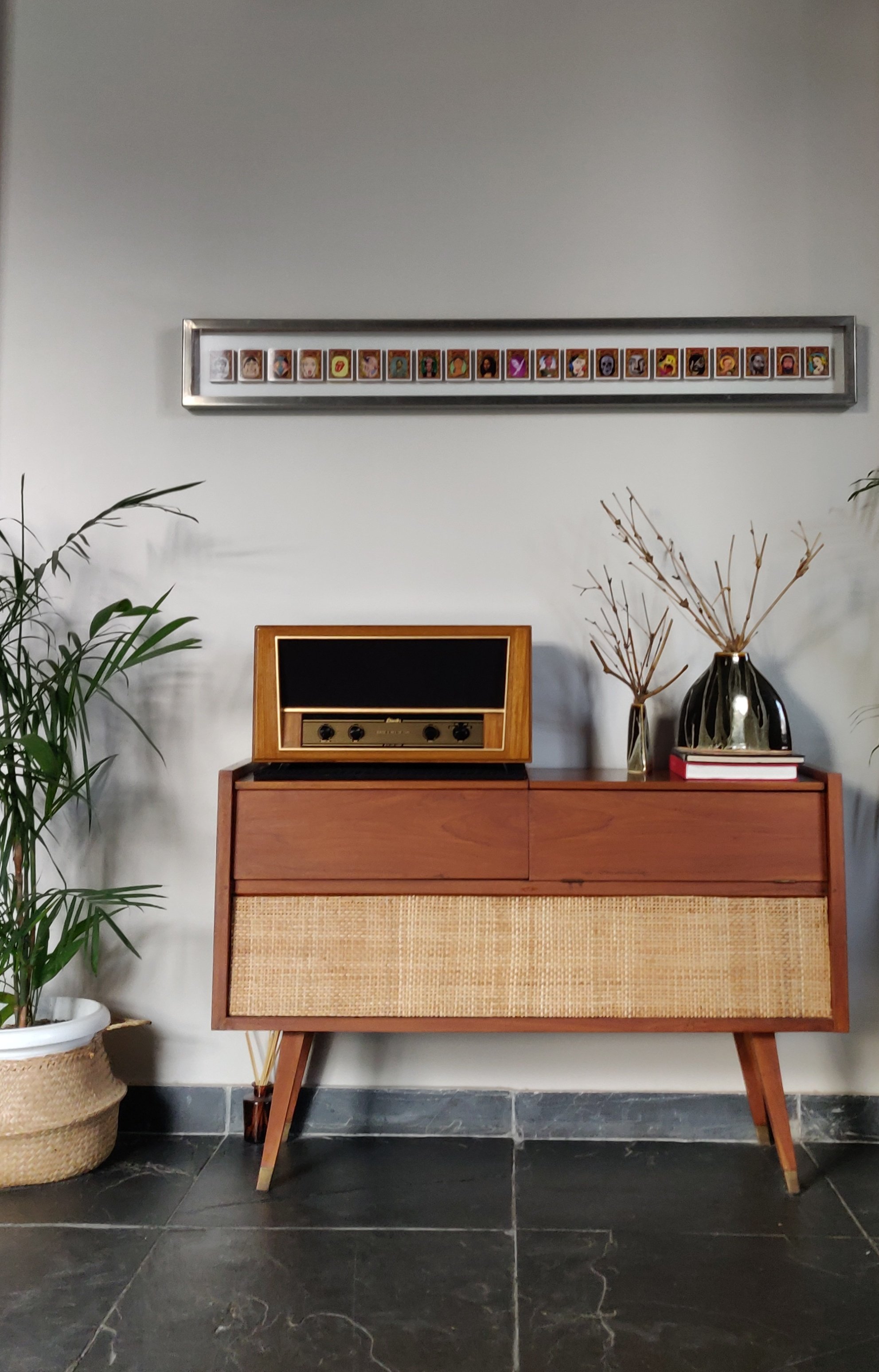The Sound of Nostalgia
By Sandra Alexander
On a regular day at work, two artisans sit in a studio in Bikaner, working over a wooden case, bringing it to life. The case is a thing of beauty, built with old wood procured from the doors and windows of old Havelis that no longer dot the city. The hands that work them come from a lineage of excellence in woodworking, a craft the historic city is renowned for, now a dwindling profession. Somehow, old pieces of Bikaner have found a way to live on in this room.
An old radio sits in a corner - the object that sets things into motion - mostly playing songs by Rafi Saab. The one currently on loop is Mann Re, his 1964 masterpiece. "It's a mood song, and everybody here is a Mohammed Rafi fan", says Diwik Singh Chhalani, founder and head designer at Diwiks - home to bespoke speaker units that are a 'confluence of impeccable sound and exquisite design'.
Diwik Singh Chhalani - Founder, Diwiks
Diwiks is the story of how objects that once enter a household become intimate obsessions of the family. They find a way into their memory of the past and their hopes for the future. The radio was brought by Diwik's grandfather many decades ago and was a precious possession of his. "Around the time he bought the radio, my father was born. They say that my grandfather heard the name Dilip Kumar on the radio and named his son Dilip. So in a way, it is the radio that my father got his name from." Surprisingly, years later, it also came to be the reason behind Diwik's namesake venture. Through Diwiks, Chhalani aims to create speakers that become repositories of memories for families, playing music through their good times and bad.
Diwik has always had an affinity with things of the past. "All old things in the house were assigned to me because I am a hoarder of such things." In 2015, when Diwik left his well-paying job in Delhi to find what he really wanted to do, little did he know that this obsession would pave the way for a new venture. Briefly after that, on one of his trips to his hometown, he discovered his grandfather's radio and brought it back to Delhi to fix it. After being scolded by shopkeepers multiple times for trying to restore something so old, Chhalani finally succeeded in getting rid of its old electronics, added a new pair of speakers to it, and installed Bluetooth. The resultant sound, he admits, was not what he had in mind, but he had realised by then that this is what he wanted to do.
The initial months at Diwiks were spent scouting for old radios so they could be remade into speakers. The walls of one of the rooms in Chhalani's studio are now adorned by the innards of radios that he found this way. But this quest sent him off in another direction. He found that the art deco Havelis, a rich part of Bikaner's heritage and his own childhood, were being razed to the ground to make way for other buildings. "Not everybody would have fallen in love with these buildings the way I did. While I was looking for old radios, the things I was seeing more and more were old wood, old design, houses and objects." So he found a way to keep them alive through his work, while also being ethically conscious of the materials he uses. Old Burmese teak wood from the 1930s and 40s, sourced from these buildings, conducts sound well and has become the cornerstone of the Diwiks speakers. Structures made from this wood can easily live for another hundred years.
Their last collection, Kastur Niwas, was an ode to a building of the same name, located near Diwik's home, that was razed down last year and includes wood and design elements from it.
What started as an effort to restore old radios has now turned into creating speaker units from scratch. After the wood is procured, it is sanded and the old paint is removed, broken pieces are joined together and fixed. This work is done by the artisans at Diwiks, Ustad Mainuddin and Manoj Suthar. Then they put together a structure and each speaker has a unique design. Their craftsmanship, combined with Diwik's vision translates into a timeless design. "I have to give them a lot of space so that they can combine their creativity and the things they've done in their past, to bring it to the fore. But I also have to draw a very subtle line so they don't leave a certain framework. We don't work with a lot of drawing because none of us can draw. Wilfully, I don't do screenshots and mood boards. It limits your visual thinking. We know what we're doing, but it's always a surprise until it comes together."
In Chhalani's pursuit to create state-of-the-art speakers, the sound was the hardest element to put together. "There are no parameters to judge what good sound is," he says. Diwiks uses a two-channel stereo system and custom-designed kevlar cone drivers that produce rich audio details and negligible harmonic distortion. "What we've tried to do is recreate a home theatre in a single case. With the speakers of today, you will see that over a period of time the sound starts biting your ear. That is because it is not well-rounded. Diwiks brings you a composed, heavy sound that is not plasticky. You can listen to it for a continued period of time."
None of these details were known to Diwik before he stumbled upon this path and learned them through repeated attempts. What made him work persistently to achieve it along with other technicians was a deep curiosity gained from his childhood when he would take things apart and put them back together with his uncle, Prakash. "No amount of education or work has helped me as much as my childhood helped me in this project. That basic engineering bent of mind, that understanding has come from just being with my uncle."
Perhaps the most striking thing about a Diwiks is that it is deeply personal. Its beauty lies also in the tinier details - brass knobs for handles, and the owner's name screen printed in gold. "There will never be LED displays on a Diwiks", says Chhalani, because it distracts from the listening experience. "I always want to make things that are not attractive on day one. It's not going to be fuchsia pink and gold with a lot of other colors. It should look simple, and still be pleasant to the eye for years to come."
This perfect blend of sound and design drove Diwiks to notable fame in the art world, when they were showcased at the India Art Fair 2020 and GallerySKE in Bengaluru. But does that put a lot of pressure on him? Growing a small business takes persistent effort and Chhalani is thankful to have gotten an amazing response, and a community of friends who cheer him forward. "The only pressure I want to take is that my client's grandchildren use this", he says.
Diwik says that the lockdowns imposed due to the pandemic have given people the extended time to consume stories and pay attention to his work. He has noticed that they are becoming increasingly conscious of whether what they're buying is handcrafted or ethically sourced, or how detailed the process is. It takes six months to create up to fifteen speakers at Diwiks because things are done manually, and more and more people are beginning to appreciate that. "It is a very therapeutic experience to work with the artisans and watch things being done by hand. You cannot experience that with so many things today, and you come to understand how things take time."
For Chhalani, the way forward is to not lose the vision of his design and keep improving within the style Diwiks has carved out for itself. One day, in the near future, he hopes to put up a Diwiks museum in an old building that is going down. "It will be amazing as and when things happen. And at that time, I hope I can support more artisans and have more unique things for people to access and see."
In creating heirlooms for the future, Diwiks restore old relationships and familiarities. "Music is such a binder. You can be in a room and let the music play and still talk and have a good time. I don't want to make something that creates instant noise and then disappears. It should nicely sit along and stay with you. I mean, I'm sure the sound will conk off. That you can get fixed. But the form in its totality will survive. Yes, you may get bored of it in 10 years, so then you will put it in your farmhouse, and then you will put it in your basement. But 20, 30, 40 years down the line, it will come back again in your grandchildren's lives and they will do something with it as I did with my grandfather's radio."







